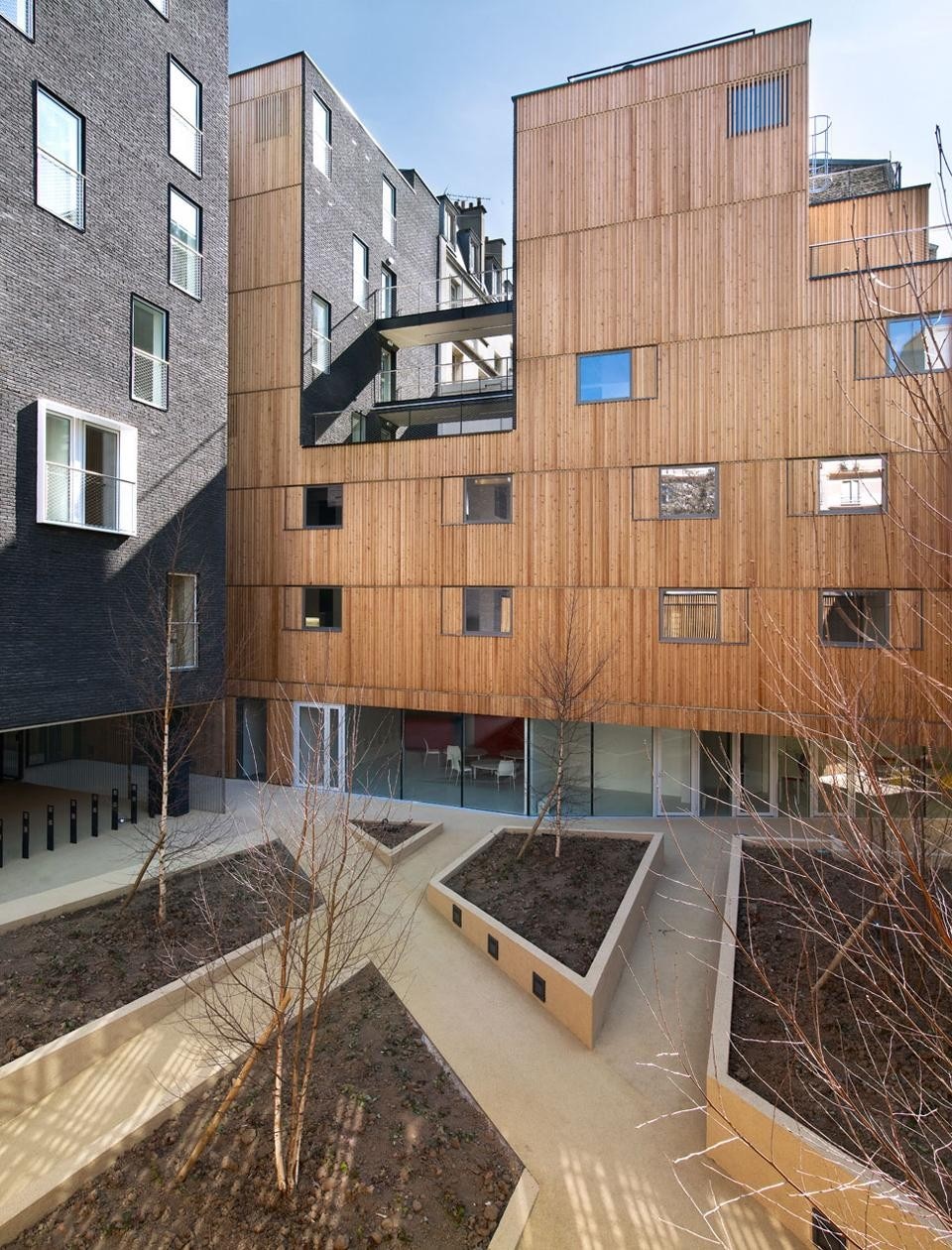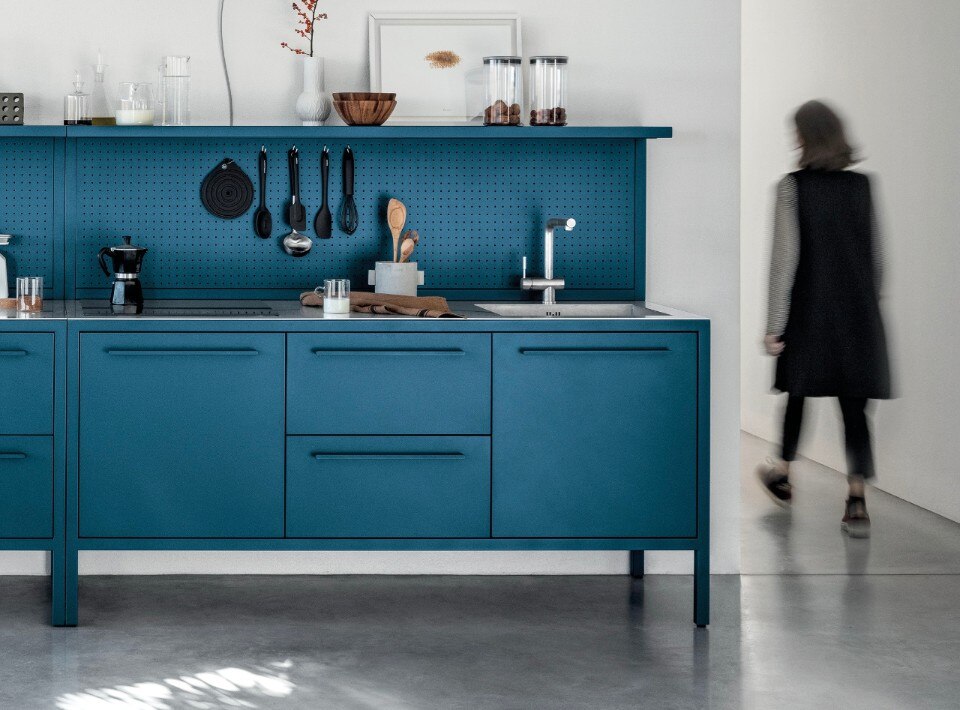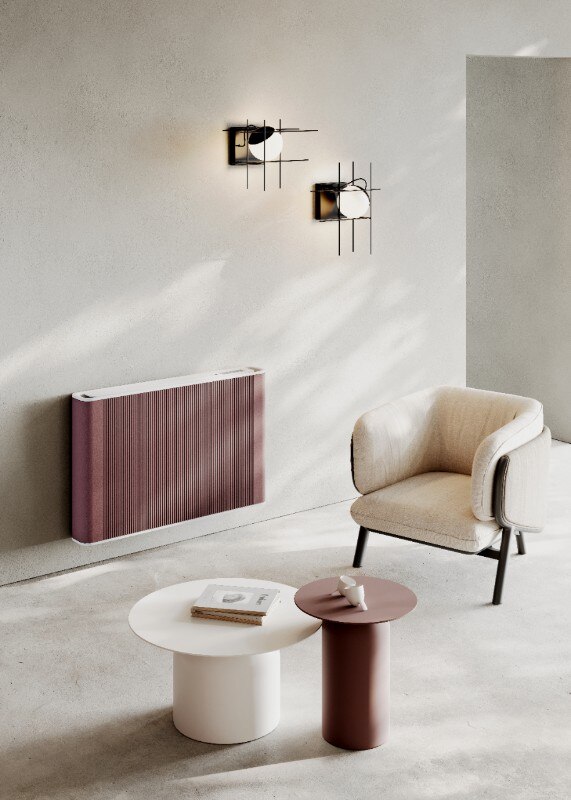The project for a student residence by LAN Architecture was considered in the context of the urban fabric of the La Chapelle district in Paris and its evolution. The plot is on the corner of rue Philippe de Girard and rue Pajol in the 18th arrondissement, close to the ZAC Pajol, an ambitious redevelopment of former railway yards, on which social, cultural and sports amenities are currently being created. The district is a very heterogeneous mixture of Haussmannian residential buildings, factories and workshops, and therefore has a richn diversity of situations unusual within Paris itself.
The street and the courtyard
The project is composed of several buildings whose volumes and voids depend on the context. On the street, three six-storey volumes are separated by two rifts providing access to the residence and vertical circulation. The heights of the buildings at the back of the plot vary according to neighbouring buildings. In the middle, a spacious courtyard is lit by a cut in the south building, an extension of an existing void. The courtyard, the heart of the project, provides access to the various buildings and defines their interrelationship. A 15x15-metre square, it ensures sunlight for all the rooms and acts as a kind of green lung.
.jpg.foto.rmedium.jpg)
The strategy of creating a duality between street and courtyard was pursued in the choice of materials. The facades, instead of imposing a single image on the project, participate in creating the varying atmospheres of the spaces they envelop and delimit. The buildings on the street are clad in dark, slate-coloured brick, while the buildings around the courtyard are clad with larch planking with folding louvred shutters in front of the windows and balconies. The facade along the entry passage is also clad with larch and signals the feeling of the space within. All the ground and wall surfaces in the courtyard are clad with the same light-coloured, flexible material, normally used for sports areas and playgrounds. The choice of materials was dictated by technical and architectural concerns. LAN's research was guided by a desire for durability and the sober, refined and classical nature of the project.

The empty spaces in the courtyard and circulations could be said to be 'junk space' in that they are by-products of the design of the buildings. The project's ambition was to give these spaces so much quality that they create a genuine value for residents. The exterior spaces, interacting with the communal spaces and acting as a buffer between private spaces, are not merely for circulation but provide the conviviality the architects sought to create. As these spaces were not part of the project specifications, their programs can be defined and developed by residents.
The empty spaces in the courtyard and circulations could be said to be 'junk space' in that they are by-products of the design of the buildings. The project's ambition was to give these spaces so much quality that they create a genuine value for residents.
.jpg.foto.rmedium.jpg)
The brief specified the construction of a student residence of around 150 rooms, communal spaces, administrative premises and a caretaker's apartment, with RIVP acting as project manager for the CROUS, which will run the residence. As one enters the residence via the rift on the left, one successively discovers the reception spaces, the administrative premises (on the corner of the street and the passageway), the communal facilities and the study and leisure areas around the courtyard. The 143 rooms have three different typologies. Students have furnished rooms with an average surface area of 18m2, with a bathroom and a kitchen area. The view of the courtyard creates a calm atmosphere conducive to concentration and study. The desks are always located near an outside view in order to benefit from natural lighting. Ten rooms were specially designed for people with reduced mobility.
.jpg.foto.rmedium.jpg)
The project complies with the "Habitat and Environment" label's VHEP specifications. A combination of compactness, treatment of the envelope, and solar heat coupled with high-performance ventilation and heating (urban heating and solar panels) creates pleasant and comfortable accommodation. The concrete structure, insulated on the outside with 12 cm of mineral wool, brick or wood cladding and high- performance double-glazed fittings, provides efficient thermal insulation. In winter the buildings retain their interior heat, and in summer their exterior insulation reduces solar and internal overheating, while inertia enables the capture of daytime heat and its retention during the night.
.jpg.foto.rmedium.jpg)
Team: LAN (architects), Franck Boutté (HEQ consultant), LGX Ingénierie (HVAC, main contractor)
Project leaders: Sebastian Niemann, Venezia Ferret
Project manager: RIVP
Location: 21 rue Pajol and 65 rue Philippe de Girard, Paris 18°
Budget: 8M € HT
Project area: 3,950 m2
Delivery: February 2011
.jpg.foto.rmedium.jpg)
This attitude has developed into a methodology enabling LAN to explore new territories and forge a vision encompassing social, urban, functional and formal questions.
LAN's projects seek to find elegant, contemporary answers to creative and pragmatic concerns. LAN has received several awards: the Nouveaux Albums de la Jeune Architecture (NAJA) prize awarded by the French Ministry of Culture and Communication (2004); the International Architecture Award from the Chicago Athenaeum and the European Urban Centre for Architecture, Art, Design and Urban Studies, the Archi-Bau Award, the Special Prize at the 12th World Triennale of Architecture, Sofia (2009); the AR Mipim Future Projects Award and the Europe 40 Under 40 Award (2010).
.jpg.foto.rmedium.jpg)

How many forms can an idea take? Fantin has the answer
One material, metal; thirty-five colors; and endless possible configurations for modern, versatile, and functional furniture: design according to Fantin.



.jpg.foto.rmedium.jpg)
